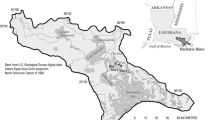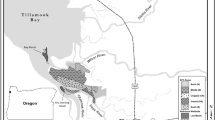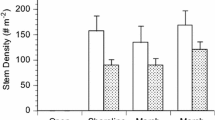Abstract
Hypersaline tidal wetland restoration sites are challenging to vegetate, and the specific factors responsible for transplant mortality are difficult to pinpoint. Two southern California sites (Tidal Linkage and Friendship Marsh), planted as large field experiments, had differential transplant survival (93% for a 1997 planting at the first site, and 10% for a 2000 planting in the second site). Multiple stresses (high salinity, sediment deposition, algal smothering and animal activity) are implicated as the cause of mortality in the experimental plantings. Greater hypersalinity and sedimentation appeared to be a function of site context, with greater sediment inflows and salt concentration over the larger (8-ha) marsh plain at the Friendship Marsh. Species differed in establishment rates among sites and years; the regional dominant, Salicornia virginica, performed best as a transplant and in volunteer seedling recruitment in the Tidal Linkage; hence, it was not planted at the larger site, where it has recruited without assistance. Frankenia salina had high survival in the 2000–2001 plantings; this species is also widespread in the region. Our attempts to restore salt marsh plain vegetation in Southern California led to greater appreciation of the importance of environmental stress and stochastic events and their potential for interaction. Hypersalinity and other factors are extremely difficult to ameliorate, especially in large restoration sites.
Similar content being viewed by others
References
Adam P 1990 Salt Marsh Ecology. Cambridge University Press, Cambridge. 461 pp.
Allison S K 1996 Recruitment and establishment of salt marsh plants following disturbance by flooding. Am. Midl. Nat. 136, 232–247.
Baldwin A H and Mendelssohn I A 1998 Effects of salinity and water level on coastal marshes: An experimental test of disturbance as a catalyst for vegetation change. Aquat. Bot. 61, 255–268.
Beare P A and Zedler J B 1987 Cattail invasion and persistence in a coastal salt marsh: The role of salinity reduction. Estuaries 10, 165–170.
Cahoon D and Turner R E 1989 Accretion and canal impacts in a rapidly subsiding wetland. II. Feldspar marker horizon technique. Estuaries 12, 260–268.
Callaway J C and Zedler J B 1998 Interactions between a salt marsh native perennial (Salicornia virginica) and an exotic annual (Polypogon monspeliensis) under varied salinity and hydroperiod. Wetlands Ecol. Manage. 5, 179–194.
Callaway J C, Sullivan G and Zedler J B Species-rich plantings increase biomass andnitrogen accumulation in a wetland restoration experiment. Ecol. Appl. (In review).
Callaway R M and Sabraw C S 1994 Effects of variable precipitation on the structure and diversity of a California salt marsh community. J. Veg. Sci 5, 433–438.
Ferren W R J 1985 Carpinteria salt marsh: Environment, history, and botanical resources of a Southern California Estuary. Publ. No. 4, The Herbarium, Department of Biological Sciences, University of California, Santa Barbara.
Ganster P 1998 Sustainable Development in San Diego and Tijuana: A View from San Diego. Center for U.S.-Mexican Studies. University of California, San Diego, San Diego, CA.
Gee G W and Bauder W 1986 Particle soil analysis. In Methods in Soil Analysis Part 1: Physical and Mineralogical Methods. </del>Ed. A Klute. pp. 399–409 American Society of Agronomy. Soil Science Society of America, Madison, WI.
Grubb P J 1977 The maintenance of species richness in plant communities: The importance of the regeneration niche. Biol. Rev. 52, 107–142.
Holmgren M, Scheffer M and Huston M A 1997 The interplay of facilitation and competition in plant communities. Ecology 78, 1966–1975.
Ibarra-Obando S E and Poumian-Tapia M 1991 The effect of tidal exclusion on salt marsh vegetation in Baja California, Mexico. Wetlands Ecol. Manage. 1, 131–148.
James M L and Zedler J B 2000 Dynamics of wetland and upland subshrubs at the salt marsh-coastal sage scrub ecotone. Am. Midl. Nat. 143, 298–311.
Jurik TW, Wang S C and Van der Valk A G 1994 Effects of sediment load on seedling emergence from wetland seed banks. Wetlands 14, 159–165.
Keer G and Zedler J B 2002 Salt marsh canopy architecture differs with the number and composition of species. Ecol. Appl. 12, 456–473.
Khan M A, Gul B and Weber D J 2001 Germination of dimorphic seeds of Suaeda moquinii under high salinity stress. Aust. J. Bot. 49, 185–192.
Kuhn N L and Zedler J B 1997 Differential effects of salinity and soil saturation on native and exotic plants of a coastal salt marsh. Estuaries 20, 391–403.
Langis R, Zalejko M and Zedler J B 1991 Nitrogen assessments in a constructed and a natural salt marsh of San Diego Bay (California, USA). Ecol. Appl. 1, 40–51.
Lindig-Cisneros R and Zedler J B 2002 Halophyte recruitment in a salt marsh restoration site. Estuaries. 25, 1175–1184.
Mahall B E and Park B P 1976 The ecotone between Spartina foliosa Trin. and Salicornia virginica L. in salt marshes of northern San Francisco Bay. J. Ecol. 64, 811–819.
Naidoo G and Naicker K 1992 Seed germination in the coastal halophytes Triglochin bulbosa and Triglochin striata. Aquat. Bot. 42, 217–229.
Neuenschwander L, Thorsted T J and Vogl R 1979 The saltmarsh and transitional vegetation of Bahía de San Quintín. Bull. S. Cal. Acad. Sci. 78, 163–182.
Noe G B and Zedler J B 2001a Spatio-temporal variation of salt marsh seedling establishment in relation to the abiotic and biotic environment. J. Veg. Sci 12, 61–74.
Noe G B and Zedler J B 2001b Variable rainfall limits the germination of upper intertidal marsh plants in southern California. Estuaries 24, 30–40.
Pearcy R W and Ustin S L 1984 Effects of salinity on growth and photosynthesis of 3 California (USA) tidal marsh species. Oecologia 62, 68–73.
Pennings S C and Callaway R M 1996 Impact of a parasitic plant on the structure and dynamics of salt marsh vegetation. Ecology 77, 1410–1419.
Richards L 1954 Diagnosis and improvement of saline and alkali soils. Agriculture Handbook No. 60, United States Department of Agriculture, Washington, D.C.
Shumway S W and Bertness M D 1992 Salt stress limitation of seedling recruitment in a salt marsh plant community. Oecologia Heidelberg 92, 490–497.
Sullivan G 2001 Establishing vegetation in restored and created coastal wetlands. In Handbook for Restoring TidalWetlands. Ed. J B Zedler. pp. 119–156. CRC Press, Boca Raton, FL.
Sullivan G and Noe G B 2001 Coastal wetland plant species of southern California. In Handbook for Restoring Tidal Wetlands. Ed. J B Zedler. pp. 369–423. CRC Press, Boca Raton, FL.
Sullivan G and Zedler J B 1999 Functional redundancy among tidal marsh halophytes: A test. Oikos 84, 246–260.
Trnka S and Zedler J B 2000 Site conditions, not parental phenotype, determine the height of Spartina foliosa. Estuaries 23, 572–582.
Ungar I A 1978 Halophyte seed germination. Bot. Rev. 44, 233–259.
Ungar I A 1998 Are biotic factors significant in influencing the distribution of halophytes in saline habitats? Bot. Rev. 64, 176–199.
Valiela I and Rietsma C S 1995 Disturbance of salt marsh vegetation by wrack mats in Great Sippewissett Marsh. Oecologia 102, 106–112.
Vince S W and Snow A A 1984 Plant zonation in an Alaskan salt marsh: 1. Distribution, abundance and environmental factors. J. Ecol. 72, 651–668.
Vogl R 1966 Salt-marsh vegetation of upper New Port Bay, California. Ecology 47, 80–87.
Waisel Y 1972 Biology of Halophytes. Academic Press, New York. 395 p.
Ward K 2000 Episodic colonization of an intertidal mudflat by cordgrass (Spartina foliosa) at Tijuana Estuary. Master's thesis. San Diego State University, San Diego.
Zedler J B 1977 Salt marsh community structure in the Tijuana Estuary, California. Estuar. Coast. Shelf Sci. 5, 39–53.
Zedler J B, Ed. 2001 Handbook for Restoring Tidal Wetlands. CRC Press, Boca Raton, Florida.
Zedler J B and Beare P A 1986 Temporal variability of salt marsh vegetation: The role of low salinity gaps and environmental stress. In Estuarine Variablity. Ed. D Wolfe. pp. 295–306. Academic Press, New York.
Zedler J B, Callaway J C and Sullivan G 2001 Declining biodiversity: Why species matter and how their functions might be restored in Californian tidal marshes. Bioscience 51, 1005–1017.
Zedler J B, Covin J, Nordby C, Williams P and Boland J 1986 Catastrophic events reveal the dynamic nature of salt-marsh vegetation in southern California (USA). Estuaries 9, 75–80.
Zedler J B, Nordby C S and Kus B E 1992 The Ecology of Tijuana Estuary. A National Estuarine Research Reserve. NOAA office of Coastal Resource Management, Sanctuaries and Reserves Division, Washington, D.C.
Zedler J B, Paling E and McComb A 1990 Differential responses to salinity help explain the replacement of native Juncus kraussii by Typha orientalis in western Australian salt marshes. Aust. J. Ecol. 15, 57–72.
Zedler J B, Winfield T and Williams P 1980 Salt marsh productivity with natural and altered tidal circulation. Oecologia 44, 236–240.
Author information
Authors and Affiliations
Corresponding author
Rights and permissions
About this article
Cite this article
Zedler, J., Morzaria-Luna, H. & Ward, K. The challenge of restoring vegetation on tidal, hypersaline substrates. Plant and Soil 253, 259–273 (2003). https://doi.org/10.1023/A:1024599203741
Issue Date:
DOI: https://doi.org/10.1023/A:1024599203741




